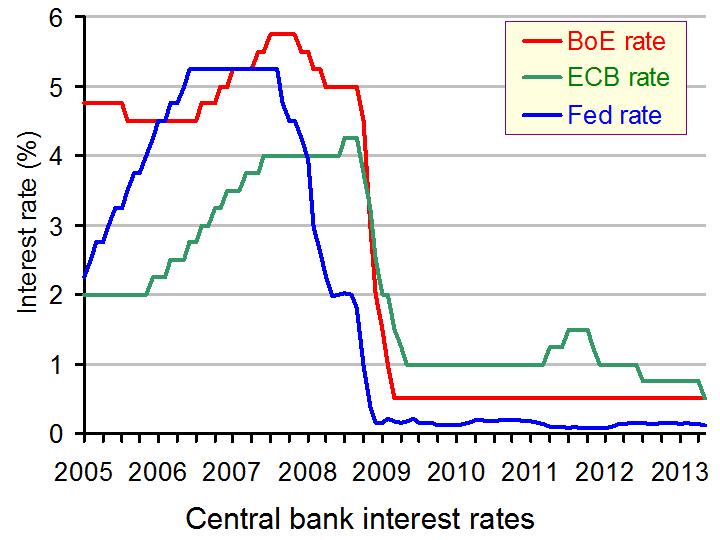 Interest rates have, for some years, been the main tool of monetary policy and of steering the macroeconomy. Across the world interest rates were lowered, in many cases to record lows, as a means of stimulating economic growth. Interest rates in the UK have been at 0.5% since March 2009 and on 2nd May 2013, the ECB matched this low rate, having cut its main interest rate from 0.75%. (Click here for a PowerPoint of the chart.)
Interest rates have, for some years, been the main tool of monetary policy and of steering the macroeconomy. Across the world interest rates were lowered, in many cases to record lows, as a means of stimulating economic growth. Interest rates in the UK have been at 0.5% since March 2009 and on 2nd May 2013, the ECB matched this low rate, having cut its main interest rate from 0.75%. (Click here for a PowerPoint of the chart.)
Low interest rates reduce the cost of borrowing for both firms and consumers and this in turn encourages investment and can boost consumer expenditure. After all, when you borrow money, you do it to spend! Lower interest rates will also reduce the return on savings, again encouraging spending and for those on variable rate mortgages, mortgage payments will fall, increasing disposable income. However, these above effects are dependent on the banks passing the ECB’s main interest rate on its customers and this is by no means guaranteed.
Following the cut in interest rates, the euro exchange rate fell almost 2 cents against the dollar.
Interest rates in the eurozone have been at 0.75%, but a 0.25 point cut was widely expected, with the ongoing debt crisis in the Eurozone continuing to adversely affect growth and confidence. A lack of trust between banks has also contributed to a lack of lending, especially to small and medium sized enterprises. The ECB has injected money into financial institutions with the aim of stimulating lending, but in many cases, banks have simply placed this extra money back with the ECB, rather than lending it to other banks or customers. The fear is that those they lend to will be unable to repay the money. In response to this, there have been suggestions of interest rates becoming negative – that is, if banks want to hold their money with the ECB they will be charged to do it. Again, the idea is to encourage banks to lend their money instead.
Small and medium sized businesses have been described as the engine of growth, but it is these businesses who have been the least able to obtain finance. Without it, they have been unable to grow and this has held back the economic recovery. Indeed, GDP in the Eurozone has now fallen for five consecutive quarters, thus prompting the latest interest rate cut. A key question, however, will be how effective this quarter of a percent cut will be. If banks were unwilling to lend and firms unwilling to invest at 0.75%, will they be more inclined at 0.5%? The change is small and many suggest that it is not enough to make much of a difference. David Brown of New View Economics said:
The ECB rate cut is no surprise as it was well flagged by Draghi at last month’s meeting. Is it enough? No. The marginal effect of the cut is very limited, but at least it should have some symbolic rallying effect on economic confidence.
This was supported by Howard Archer at HIS Global Insight, who added:
Admittedly, it is unlikely that the trimming of interest rates from 0.75% to 0.5% will have a major growth impact, especially given fragmented credit markets, but any potential help to the eurozone economy in its current state is worthwhile.
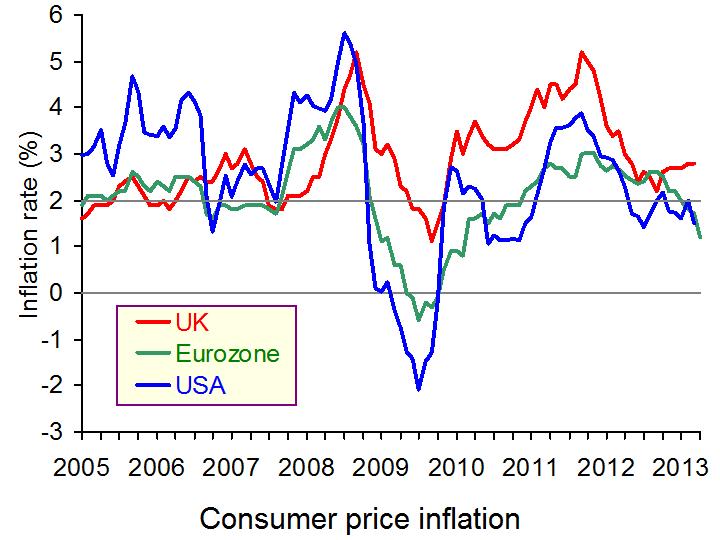 Inflation in the eurozone is only at 1.2%, which is significantly below the ceiling of 2%, so this did give the ECB scope for the rate to be cut. (Click here for a PowerPoint of the chart.) After all, when interest rates fall, the idea is to boost aggregate demand, but with this, inflation can emerge. Mr Draghi said ‘we will monitor very closely all incoming information, and assess any impact on the outlook for price stability’. The primary objective of the ECB is the control of inflation and so had inflation been somewhat higher, we may have seen a different decision by the ECB. However, even then, 5 consecutive quarters of negative growth is hard to ignore.
Inflation in the eurozone is only at 1.2%, which is significantly below the ceiling of 2%, so this did give the ECB scope for the rate to be cut. (Click here for a PowerPoint of the chart.) After all, when interest rates fall, the idea is to boost aggregate demand, but with this, inflation can emerge. Mr Draghi said ‘we will monitor very closely all incoming information, and assess any impact on the outlook for price stability’. The primary objective of the ECB is the control of inflation and so had inflation been somewhat higher, we may have seen a different decision by the ECB. However, even then, 5 consecutive quarters of negative growth is hard to ignore.
So, if these lower interest rates have little effect on stimulating an economic recovery, what about a movement away from austerity? Many have been calling for stimulus in the economy, arguing that the continuing austerity measures are stifling growth. The European Council President urged governments to promote growth and job creation. Referring to this, he said:
Taking these measures is more urgent than anything … After three years of firefights, patience with austerity is wearing understandably thin.
However, Mr. Draghi urged for policymakers to stick with austerity and continue to focus on bringing debt levels down, while finding other ways to stimulate growth, including structural reform. The impact of this latest rate cut will certainly take time to filter through the economy and will very much depend on whether the 0.5% interest rate is passed on to customers, especially small businesses. Confidence and trust within the financial sector is therefore key and it might be that until this emerges, the eurozone itself is unlikely to emerge from its recession.
ECB ready to enter unchartered waters as bank cuts interest rate to fresh low of 0.5pc The Telegraph, Szu Ping Chan (2/5/13)
Draghi urges Eurozone governments to stay the course on austerity Financial Times, Michael Steen (2/5/13)
Eurozone interest rates cut to a record low of 0.5% The Guardian, Heather Stewart (2/5/13)
ECB’s Draghi ‘ready to act if needed’ BBC News (2/5/13)
Eurozone interest rates cut again as ECB matches Bank of England Independent, Russell Lynch (3/5/13)
Margio Draghi urges no let-up in austerity reforms after Eurozone rate cut – as it happened The Guardian, Graeme Wearden (2/5/13)
ECB cuts interest rate to record-low 0.5% in desperate measure to drag Eurozone out of recession Mail Online, Simon Tomlinson and Hugo Duncan (2/5/13)
ECB cuts interest rates, open to further action Reuters, Michael Shields (2/5/13)
Eurozone loosens up austerity, slowly Wall Street Journal (2/5/13)
ECB cuts interest rate, not enough to pull the region out of recession The Economic Times of India (2/5/13)
Euro steady ahead of ECB interest rate announcement Wall Street Journal, Clare Connaghan (2/5/13)
 European Central Bank (ECB) cuts interest rates BBC News (2/5/13)
European Central Bank (ECB) cuts interest rates BBC News (2/5/13)
All eyes on ECB as markets expect rate cut Financial Times, Michael Steen (2/5/13)
Questions
- How is a recession defined?
- Using an aggregate demand/aggregate supply diagram, illustrate and explain the impact that this cut in interest rates should have.
- On which factors will the effectiveness of the cut in interest rates depend?
- Using the interest rate and exchange rate transmission mechanisms to help you, show the impact of interest rates on the various components of aggregate demand and thus on national output.
- What would be the potential impact of a negative interest rate?
- Why did the low inflation rate give the ECB scope to cut interest rates?
- What are the arguments for and against austerity measures in the Eurozone, given the 5 consecutive quarters of negative growth?
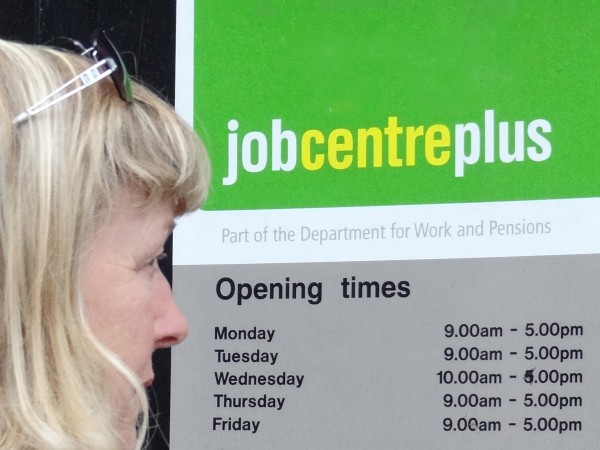 Unemployment is a key macroeconomic objective for governments across the world. The unemployment rate for the UK now stands at 7.9% according to the ONS, which recorded 2.56 million people out of work. But why is unemployment of such importance? What are the costs?
Unemployment is a key macroeconomic objective for governments across the world. The unemployment rate for the UK now stands at 7.9% according to the ONS, which recorded 2.56 million people out of work. But why is unemployment of such importance? What are the costs?
The economy is already in a vulnerable state and with unemployment rising by 70,000 people between December and February 2013, the state of the economic recovery has been questioned. Indeed, following the news of the worsening unemployment data, the pound fell significantly against the dollar, suggesting a lack of confidence in the British economy.
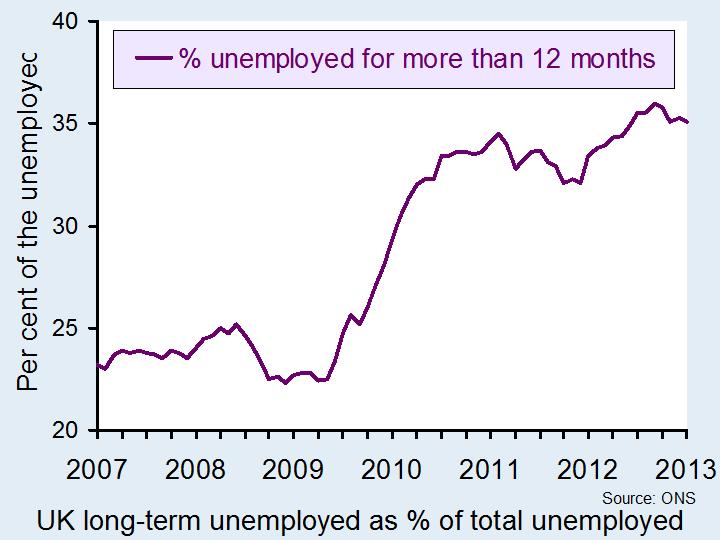 Although the increase in the number of people out of work is concerning, perhaps of more concern should be the number of long-term unemployed. The ONS suggests that more than 900,000 have now been out of work for more than a year. Not only does this pose costs for the individual in terms of lost earnings and skills, but it also imposes costs on friends and family and the wider economy. (Click here for a PowerPoint of the first chart, which shows the percentage of unemployed people out for work longer than 12 months.)
Although the increase in the number of people out of work is concerning, perhaps of more concern should be the number of long-term unemployed. The ONS suggests that more than 900,000 have now been out of work for more than a year. Not only does this pose costs for the individual in terms of lost earnings and skills, but it also imposes costs on friends and family and the wider economy. (Click here for a PowerPoint of the first chart, which shows the percentage of unemployed people out for work longer than 12 months.)
The chief executive of the Prince’s Trust focused on the costs of youth unemployment in particular, saying:
Thousands of these young people are long-term unemployed, often facing further challenges such as poverty and homelessness. We must act now to support these young people into work and give them the chance of a better future.
(Click here for a PowerPoint of the second chart, which shows how much higher the unemployment rate is for young people aged 18 to 24 than it is for the working age population as a whole.)
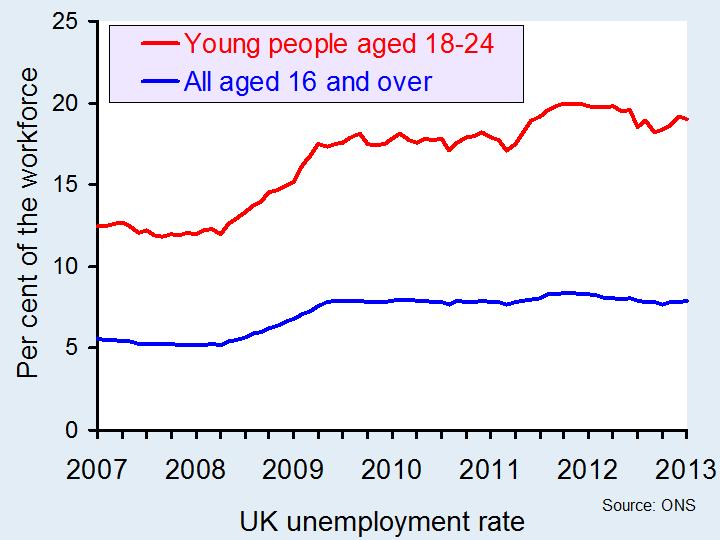 Furthermore, with so many people unemployed, we are operating below full-employment and thus below our potential output. Furthermore, the longer people are out of work, the more likely it is that they will lose their skills and thus require re-training in the future or find that there are now fewer jobs available to them based on their lower skill level.
Furthermore, with so many people unemployed, we are operating below full-employment and thus below our potential output. Furthermore, the longer people are out of work, the more likely it is that they will lose their skills and thus require re-training in the future or find that there are now fewer jobs available to them based on their lower skill level.
In addition to this there are monetary costs for the government through lower tax receipts, in terms of income tax, national insurance contributions and even VAT receipts. With more people unemployed, the numbers claiming various unemployment-related benefits will rise, thus imposing a further cost on the government and the taxpayer. Another cost to the government of this latest data is likely to be the expectations of the future course of the economy. Numerous factors affect business confidence and unemployment data is certainly one of them. The concern is that business confidence affects many other variables as well and until we receive more positive data, the economy recovery is likely to remain uncertain. The following articles consider this topic.
UK unemployment rise adds to pressure on Osborne’s austerity strategy The Guardian, Phillip Inman (18/4/13)
Unemployment figures are ‘worrying’, David Cameron’s spokesman says The Telegraph, Peter Dominiczak (17/4/13)
UK unemployment rises to 2.56 million BBC News (17/4/13)
Unemployment jumps to 7.9% as rise in the number of young people out of work takes figure ‘dangerously’ close to a million Mail Online, Leon Watson (17/4/13)
Unemployment up as stay-at-home mothers head back to the job-centre Independent, Ben Chu (17/4/13)
Jobs data points to finely balanced market Financial Times, Brian Groom (18/4/13)
 Hugh’s review: making sense of the stats BBC News (19/4/13)
Hugh’s review: making sense of the stats BBC News (19/4/13)
Questions
- How is unemployment measured?
- What are the costs to the individual of being unemployed?
- What are the wider non-monetary costs to society?
- Explain the main financial costs to the wider economy of a rising unemployment rate.
- Illustrate the problem of unemployment by using a production possibility frontier.
- Could there be a negative multiplier effect from a rise in unemployment?
 House prices have long been an obsession with the UK media and much of the public; when they rise, homeowners feel rich, when they fall, consumer confidence dives. Following the financial crisis and subsequent recession, there has been a great deal of attention focused on the overall health of the housing market.
House prices have long been an obsession with the UK media and much of the public; when they rise, homeowners feel rich, when they fall, consumer confidence dives. Following the financial crisis and subsequent recession, there has been a great deal of attention focused on the overall health of the housing market.
But the UK faces a particular problem of a sharp and growing divide in regional house prices. First time buyers in London face having to find high deposits and even then, many are unable to access mortgages. Meanwhile those in the regions can access more affordable housing, but may be reluctant to enter the market when prices are stagnant. What are the implications of this divide for the housing market and for the broader economy?
The housing market demonstrates characteristics which are typical of those for goods that are both consumable and involve capital growth; when prices rise housing is seen as a good ‘investment’ and demand increases, this in turn leads to higher prices. Conversely when values drop, demand falls and the market slumps. Markets like this are described as being prone to price bubbles.
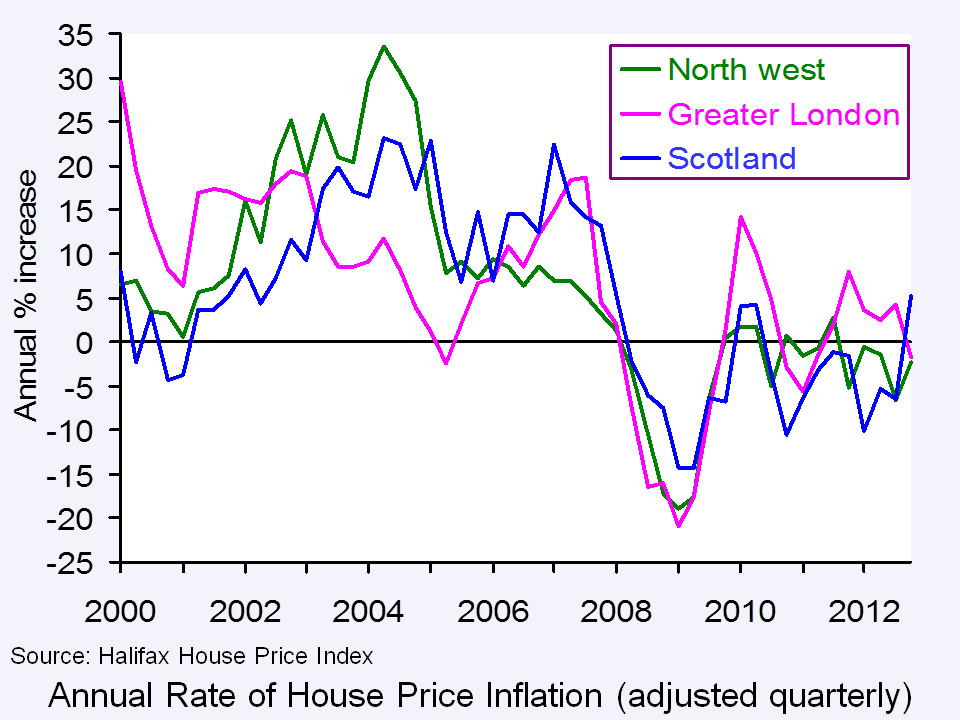 Looking at UK house prices as a whole can, however, mask large variations across the economy; variations which can cause problems for jobseekers, for employers and for the government. Recently one of the UK’s largest mortgage lenders predicted continuing regional variance in house prices. Halifax’s figures looked at the price of housing across a number of UK towns and showed that changes seen during 2012 ranged from a 14.8 per cent rise to an 18.4 per cent fall. The biggest rise seen during the year was in Southend on Sea, in Essex, while the greatest fall was in Craigavon, in Northern Ireland. Of the ten towns with the biggest rises, eight were found in London or the south east, with Durham being the only northern town showing growth. Of the ten towns that the Halifax identified with the biggest falls, four are in Scotland, three are in the north west, one is in the north of England and one is in Northern Ireland.
Looking at UK house prices as a whole can, however, mask large variations across the economy; variations which can cause problems for jobseekers, for employers and for the government. Recently one of the UK’s largest mortgage lenders predicted continuing regional variance in house prices. Halifax’s figures looked at the price of housing across a number of UK towns and showed that changes seen during 2012 ranged from a 14.8 per cent rise to an 18.4 per cent fall. The biggest rise seen during the year was in Southend on Sea, in Essex, while the greatest fall was in Craigavon, in Northern Ireland. Of the ten towns with the biggest rises, eight were found in London or the south east, with Durham being the only northern town showing growth. Of the ten towns that the Halifax identified with the biggest falls, four are in Scotland, three are in the north west, one is in the north of England and one is in Northern Ireland.
Martin Ellis, housing economist at the Halifax, said:
We expect continuing broad stability in house prices nationally in 2013. The generalised north/south divide in house price performance seen during 2012 is likely to continue next year. House prices are expected to be strongest in London and the south east as this part of the country performs best in economic terms.
These disparities present a particular problem in a recession. While London and the south east show signs of economic growth, with relatively low unemployment and high levels of inward investment, many regions outside London see house prices falling further as unemployment grows. There are some exceptions – the arrival of the BBC in Salford has resulted in a sharp increase in prices there – but, in general, confidence is low outside the south east.
The articles below consider regional differences in the housing market.
Articles
House prices creep up over 2012 The Guardian, Patrick Collinson (29/1/13)
Which regions of the UK will show the biggest house price rises in the next 5 years? This is Money, Rachel Rickard Straus (17/1/13)
Figures reveal scale of regional house price divide Inside Housing, Tom Lloyd (2/1/13)
Property market gets a budget boost, so are things looking up? This is Money, Simon Lambert (21/3/13)
Help to Buy scheme could drive up house prices, says OBR The Guardian, Josephine Moulds and Jennifer Rankin (26/3/13)
London house prices outstrip 2007 peak with a 2.8% increase The Guardian, Hilary Osborne (28/3/13)
Housing market in southeast is worth £2tn Financial Times, James Pickford and Ed Hammond (1/2/13)
House prices show annual increase Evening Standard (28/3/13)
House price data
Links to house price data The Economics Network
Regional Historical House Price Data Halifax House Price Index (Lloyds Banking Group)
Questions
- Thinking about the market for owner-occupied housing, what are the factors that will determine demand? How might these explain variations in demand across different regions of the UK?
- How does the supply of housing vary across the UK?
- What would you predict about regional variations in rents?
- What is the impact of high house prices in London on first time buyers? Does this matter?
- What are the implications for the labour market of sharp variations in house prices across regions?
- Why might the Chancellor want to put in place policies to boost the housing market?
- Who gains from high house prices? Who loses? You might want to think about this in term of the life-cycle.
 The UK economy is suffering from a lack of aggregate demand. Low spending in real terms is preventing the economy from growing. A simple solution would seem to be to stimulate aggregate demand through fiscal policy, backed up by even looser monetary policy. But this is easier said than done and could result in undesirable consequences in the medium term.
The UK economy is suffering from a lack of aggregate demand. Low spending in real terms is preventing the economy from growing. A simple solution would seem to be to stimulate aggregate demand through fiscal policy, backed up by even looser monetary policy. But this is easier said than done and could result in undesirable consequences in the medium term.
If increased borrowing were to be used to fund increased government expenditure and/or cuts in taxes, would any resulting growth be sufficient in the medium term to reduce the public-sector deficit below the initial level through automatic fiscal stabilisers? And would the growth be sustainable? The answer to this second question depends on what happens to the supply side of the economy. Would there be an increase in aggregate supply to match the increase in aggregate demand?
 This second question has led many economists to argue that we need to see a rebalancing of the economy. What is needed is an increase in investment and exports, rather than an increase in just consumer expenditure funded by private borrowing and government current expenditure funded by public borrowing.
This second question has led many economists to argue that we need to see a rebalancing of the economy. What is needed is an increase in investment and exports, rather than an increase in just consumer expenditure funded by private borrowing and government current expenditure funded by public borrowing.
But how will exports and investment be stimulated? As far as exports are concerned, it was hoped that the depreciation of the pound since 2008 would give UK exporters a competitive advantage. Also domestic producers would gain a competitive advantage in the UK from imports becoming more expensive. But the current account deficit has actually deteriorated. According to the EU’s AMECO database, in 2008 the current account deficit was 1% of GDP; in 2012 it was 3.7%. It would seem that UK producers are not taking sufficient advantage of the pound’s depreciation, whether for exports or import substitutes.
 As far as investment is concerned, there are two major problems. The first is the ability to invest. This depends on financing and things such as available land and planning regulations. The second is the confidence to invest. With not little or no growth in consumer demand, there is little opportunity for the accelerator to work. And with forecasts of sluggish growth and austerity measures continuing for some years, there is little confidence in a resurgence in consumer demand in the future. (Click here for a PowerPoint of the above chart. Note that the 2013 plots are based on AMECO forecasts.)
As far as investment is concerned, there are two major problems. The first is the ability to invest. This depends on financing and things such as available land and planning regulations. The second is the confidence to invest. With not little or no growth in consumer demand, there is little opportunity for the accelerator to work. And with forecasts of sluggish growth and austerity measures continuing for some years, there is little confidence in a resurgence in consumer demand in the future. (Click here for a PowerPoint of the above chart. Note that the 2013 plots are based on AMECO forecasts.)
So hope of a rebalancing is faint at the current time. Hence the arguments for an increase in government capital expenditure that we looked at in the last blog post (The political dynamite of calm economic reflection). The problem and the options for government are considered in the following articles.
Articles
Budget 2013: Chancellor’s rebalancing act BBC News, Stephanie Flanders (11/3/13)
Why George Osborne is failing to rebalance the economy The Guardian, Larry Elliott (17/3/13)
Economy fails to ‘rebalance’ Financial Times, Sarah O’Connor (27/2/13)
Analysis – Long haul ahead for Britain’s struggling economy Reuters, William Schomberg (3/3/13)
Can banks be forced to lend more? BBC News, Robert Peston (12/3/13)
Budget 2013: What the commentators are saying BBC News (13/3/13)
Data
UK Trade, January 2013 (ONS) (12/3/13)
Business investment, Q4 2012 ONS (27/2/13)
Questions
- Draw a diagram to illustrate the effects of a successful policy to increase both aggregate demand and aggregate supply. What will determine the effect on the output gap?
- For what reasons has the UK’s current account deteriorated over the past few years while those of the USA and the eurozone have not?
- Using ONS data, find out what has happened to the UK’s balance of trade in (a) goods and (b) services over the past few years and explain your findings.
- Why are firms reluctant to invest at the moment? What policy measures could the government adopt to increase investment?
- With interest rates so low, why don’t consumers borrow and spend more, thereby aiding the recovery?
 Moody’s, one of the three main international credit rating agencies, has just downgraded the UK’s credit rating from the top Aaa rating to Aa1. The other two agencies, Standard & Poor’s and Fitch may follow suit as they have the UK’s triple A rating on ‘negative outlook’.
Moody’s, one of the three main international credit rating agencies, has just downgraded the UK’s credit rating from the top Aaa rating to Aa1. The other two agencies, Standard & Poor’s and Fitch may follow suit as they have the UK’s triple A rating on ‘negative outlook’.
The reason for Moody’s decision can be see in its press statement:
The key interrelated drivers of today’s action are:
1. The continuing weakness in the UK’s medium-term growth outlook, with a period of sluggish growth which Moody’s now expects will extend into the second half of the decade;
2. The challenges that subdued medium-term growth prospects pose to the government’s fiscal consolidation programme, which will now extend well into the next parliament;
3. And, as a consequence of the UK’s high and rising debt burden, a deterioration in the shock-absorption capacity of the government’s balance sheet, which is unlikely to reverse before 2016.
The direct economic consequences of Moody’s action are likely to be minimal. People were excpecting a downgrade sooner or later for the reasons Moody’s quotes. Thus stock markets, bond markets and foreign exchange markets already reflect this. Indeed, in the first seven weeks of 2013, the sterling exchange rate index has depreciated by over 6%.
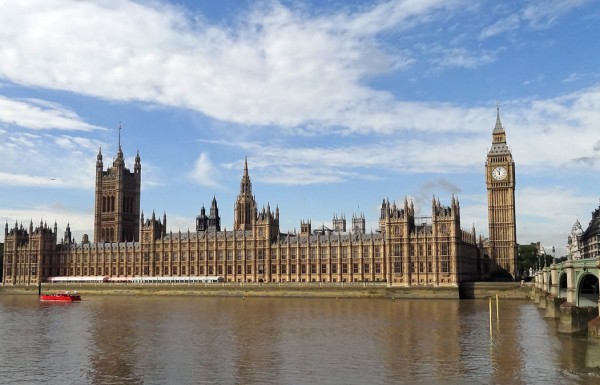 The political consequences, however, are likely to be significant. The Chancellor of the Exchequer, George Orborne, has put considerable emphasis on the importance of maintaining a triple A rating. He has seen it as a sign of the confidence of investors in the government’s policy of focusing on cutting the public-sector deficit and, ultimately, of cutting the public-sector debt as a proportion of GDP. His response, therefore, has been that the government will redouble its efforts to reduce the deficit.
The political consequences, however, are likely to be significant. The Chancellor of the Exchequer, George Orborne, has put considerable emphasis on the importance of maintaining a triple A rating. He has seen it as a sign of the confidence of investors in the government’s policy of focusing on cutting the public-sector deficit and, ultimately, of cutting the public-sector debt as a proportion of GDP. His response, therefore, has been that the government will redouble its efforts to reduce the deficit.
Not surprisingly the Labour opposition claims the downgrading is evidence that the government’s austerity policies are not working. If the aim is to cut the deficit/GDP ratio, this is difficult if GDP is falling or just ‘flat lining’. A less aggressive austerity policy, it is argued, would allow growth to recover and this rise in the denominator would allow the deficit/GDP ratio to fall.
Latest forecasts are that government borrowing is set to rise. The average of 24 independent forecasts of the UK economy, published by the Treasury on 13/2/13, is that public-sector net borrowing will rise from £90.7bn in 2012/13 to £107bn in 2013/14. And the European Commission forecast of the UK economy is that the general government deficit will rise from 5.9% of GDP in 2012/13 to 7.0% of GDP in 2013/14.
So what will be the economic and political consequences of the loss of the triple A rating? What policy options are open to the government? The following articles explore these questions. Not surprisingly, they don’t all agree!
Downgrading Britain: The Friday night drop The Economist, Buttonwood’s notebook (23/2/13)
Rating downgrade: Q&A The Observer, Josephine Moulds (24/2/13)
Downgrade is Osborne’s punishment for deficit-first policy The Guardian, Phillip Inman (23/2/13)
Britain’s downgraded credit rating: Moody’s wake-up call must trigger a change of course The Observer (24/2/13)
Editorial: AAA loss is a sign of failure Independent (24/2/13)
It’s not the end of the world – but it’s the end of any false complacency Independent, Hamish McRae (24/2/13)
Moody’s downgrade will stiffen George Osborne’s resolve The Telegraph, Kamal Ahmed (23/2/13)
UK AAA downgrade: Budget is now George Osborne’s make or break moment The Telegraph, Philip Aldrick (23/2/13)
Britain’s credit downgrade is a call to live within our means The Telegraph, Liam Halligan (23/2/13)
Britain will take years to earn back AAA rating, says Ken Clarke The Telegraph, Rowena Mason (24/2/13)
Questions
- How important are credit agencies’ sovereign credit ratings to a country (a) economically; (b) politically? Why may the political effects have subsequent economic effects?
- Explain the meaning of the terms ‘exogenous’ and ‘endogenous’ variables. In terms of the determination of economic growth, are government expenditure and tax revenue exogenous or endogenous variables? What are the implications for a policy of cutting the government deficit?
- Identify the reasons for the predicted rise in the public-sector deficit as a proportion of GDP. Which of these, if any, are ‘of the government’s own making’?
- In the absence of a change in its fiscal stance, what policies could the government adopt to increase business confidence?
 Interest rates have, for some years, been the main tool of monetary policy and of steering the macroeconomy. Across the world interest rates were lowered, in many cases to record lows, as a means of stimulating economic growth. Interest rates in the UK have been at 0.5% since March 2009 and on 2nd May 2013, the ECB matched this low rate, having cut its main interest rate from 0.75%. (Click here for a PowerPoint of the chart.)
Interest rates have, for some years, been the main tool of monetary policy and of steering the macroeconomy. Across the world interest rates were lowered, in many cases to record lows, as a means of stimulating economic growth. Interest rates in the UK have been at 0.5% since March 2009 and on 2nd May 2013, the ECB matched this low rate, having cut its main interest rate from 0.75%. (Click here for a PowerPoint of the chart.) Inflation in the eurozone is only at 1.2%, which is significantly below the ceiling of 2%, so this did give the ECB scope for the rate to be cut. (Click here for a PowerPoint of the chart.) After all, when interest rates fall, the idea is to boost aggregate demand, but with this, inflation can emerge. Mr Draghi said ‘we will monitor very closely all incoming information, and assess any impact on the outlook for price stability’. The primary objective of the ECB is the control of inflation and so had inflation been somewhat higher, we may have seen a different decision by the ECB. However, even then, 5 consecutive quarters of negative growth is hard to ignore.
Inflation in the eurozone is only at 1.2%, which is significantly below the ceiling of 2%, so this did give the ECB scope for the rate to be cut. (Click here for a PowerPoint of the chart.) After all, when interest rates fall, the idea is to boost aggregate demand, but with this, inflation can emerge. Mr Draghi said ‘we will monitor very closely all incoming information, and assess any impact on the outlook for price stability’. The primary objective of the ECB is the control of inflation and so had inflation been somewhat higher, we may have seen a different decision by the ECB. However, even then, 5 consecutive quarters of negative growth is hard to ignore. European Central Bank (ECB) cuts interest rates BBC News (2/5/13)
European Central Bank (ECB) cuts interest rates BBC News (2/5/13)








